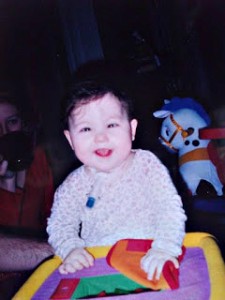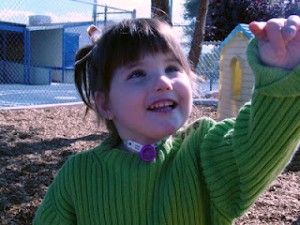by Shelley Colquitt, mother of two daughters, one who spent time in the NICU as a result of a rare disease

Photo credit: Colquitt Family
I was excited and scared when we finally got to bring our youngest daughter, Mighty Z, home from the hospital. It had been six long months since she had been born with Congenital Central Hypoventilation Syndrome (CCHS), and during that time she had been trached and vented. Before the hospital would allow us to bring Mighty Z home, they prepared us to care for her and taught us how to troubleshoot problems that might arise. Her doctors and nurses made sure we understood how important it was to keep Mighty Z, a baby who had been intubated and was still trached and vented, away from every contagious “bug” that tried to bite her. RSV, the flu or even the common cold, could result in not just sickness for Mighty Z, but in her death.
Handwashing Is No Joke
As Mighty Z’s primary caretaker, it was up to me to keep her safe in a sneezing, coughing, runny-nose world, and I took that responsibility seriously. After her long-awaited homecoming, everyone who graced my threshold was interrogated as to whether they had a fever, a cough, the sniffles or anything else that might land Mighty Z back in the pediatric intensive care unit (PICU) before being allowed inside our home. Those who gained entry to the foyer were requested (instructed!) to remove their shoes and sanitize their hands before they could go any deeper into the house. Despite my precautions, I knew it was impossible to keep all contagious illnesses away from Mighty Z, and I lived in fear of one illness in particular, RSV.
Educate Yourself About RSV
Though RSV infection can occur in people of all ages, preemies, infants and very young children are particularly susceptible. Older children who are infected with RSV usually have only mild, cold-like symptoms such as a cough, stuffy nose or low-grade fever, while infants under age one are more likely to experience more severe symptoms that result in trouble breathing. A child who has been trached and vented, or even intubated for even as little as one day, has scar tissue from those procedures in the lungs. That scar tissue makes such children especially susceptible to having an ordinary childhood illness become something substantially more catastrophic than it might otherwise.
Outbreaks of RSV begin most often in the fall and run into the spring. The virus is spread through tiny droplets that go into the air when an infected person blows their nose, coughs or sneezes. In general, RSV symptoms usually appear 4 – 6 days after coming in contact with the virus.
Symptoms include:
- Bluish skin color due to a lack of oxygen (cyanosis);
- Breathing difficulty or labored breathing;
- Cough;
- Croupy cough (often described as a “seal bark” cough);
- Fever;
- Nasal Flaring;
- Rapid breathing (tachypnea);
- Shortness of breath;
- Stuffy nose; and,
- Wheezing
Antibody Shots Buy Time
Even healthy, full-term babies and toddlers can wind up with a breathing tube and on a respirator due to RSV, and her doctors knew what it could do to a child like Mighty Z, who had scar tissue in her lungs as a result of the respiratory treatments necessary to care for her rare disease.
In order to help keep Mighty Z RSV-free, her doctors prescribed monthly Palivizumab (Synagis®) shots for her between the ages of 6-months and 24-months, after which point her doctors felt she would be “out of the woods” and better able to fight infection. Synagis®, a man-made antibody to RSV, is costly both to obtain and to administer, as it is typically given in the Synagis® clinic at a pulmonologist’s office. In my experience, it costs approximately $1,500 per dose now compared with about $3,000 per dose 10 years ago. Because of the cost, our insurance didn’t want to pay for Mighty Z to get monthly Synagis® vaccinations, and it was only after much arguing that I persuaded our insurance company to pay for the cost of the antibody itself. There was a catch, though, as their agreement to pay for the antibody cost was conditional upon my agreement to administer the vaccinations to Mighty Z myself, instead of taking her into the pulmonologist’s office every month to get shots.
After we negotiated our agreement, once a month our insurance company sent a syringe and two vials to our door. One of the vials contained powdered Synagis®, and the other contained sterile water. I mixed the powdered Synagis® antibody with the sterile water to reconstitute the shot, drew it up with the syringe, and then gave the shot to Mighty Z once a month.
Although giving Mighty Z her monthly Synagis® shot was almost unbearable (giving your own child a shot is even worse than watching someone else do it), I did it anyway. Even though Mighty Z and I both hated the shots, I knew she needed them.
RSV is Serious Business for Respiratory-Compromised Children

Photo credit: Colquitt Family
When Mighty Z turned two, I was over the moon! Not only had Mighty Z doubled the one-year life expectancy her doctors had foretold when she was initially diagnosed with CCHS (Yippee!!), but also I would no longer have to give her Synagis® shots (Yay!). Unfortunately, my elation about no longer having to give Mighty Z monthly shots was short-lived, as she became infected with RSV after only a month without shots. Though she had to spend the next two months in the PICU fighting for her life, Mighty Z won her battle. Looking back now, I believe that Mighty Z survived RSV infection at age two because of the precautions undertaken to keep her RSV-free until she was old enough and strong enough to win the fight.
If your child has ever been either intubated or trached and vented for any amount of time, tell your guests with sniffles that you’ll see them later. Require those that make the cut to take off their shoes and wash their hands, and put on your chemist and nurse hats to administer RSV shots if prescribed by your doctor and that’s what it takes to get the cost covered. In short, if your baby has ever been considered medically fragile, sometimes you’ll have to do whatever it takes to increase your child’s chance of beating the bugs.
Sources:
MedImmune – RSV Protection – This website, which is sponsored by the maker of Synagis®, provides information about RSV including who is at risk, how to prevent the virus, and when RSV season occurs.
Shelley Colquitt is the mommy of two beautiful girls, Lauren and Zoe. Her youngest daughter was born at 40 weeks. As they celebrated the success of the labor and delivery, her baby stopped breathing. Later she was diagnosed as having a rare disease that only at the time (11 years ago) 163 babies in the world had. Shelley had to learn to take care of her baby, who had a trach and was on life support machines 24 hours a day. Not only is Shelley busy with her two girls and works very hard to keep her youngest chronic medically-complex child healthy, she also volunteers at a shelter for abused/neglected children and as a teacher’s aid for globally delayed children. Follow her journey at her blog: Confessions of a Sleep Deprived Momma.
